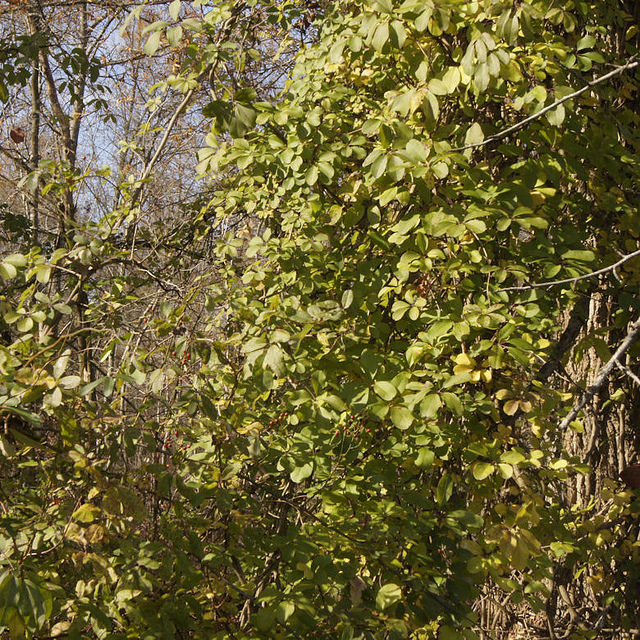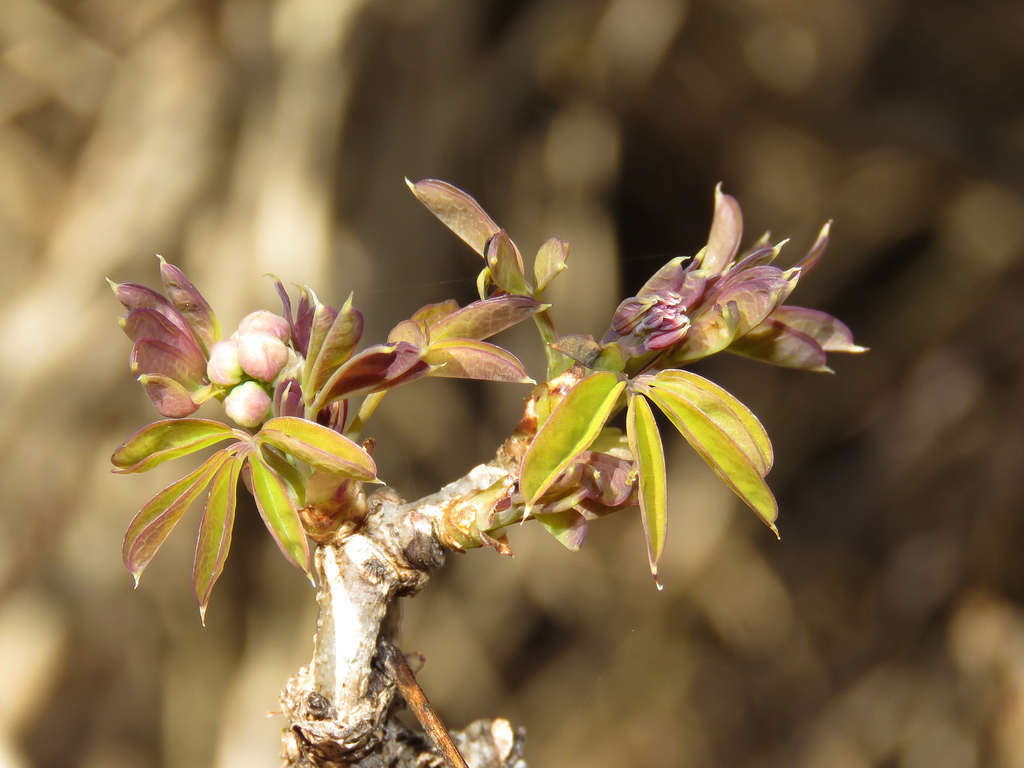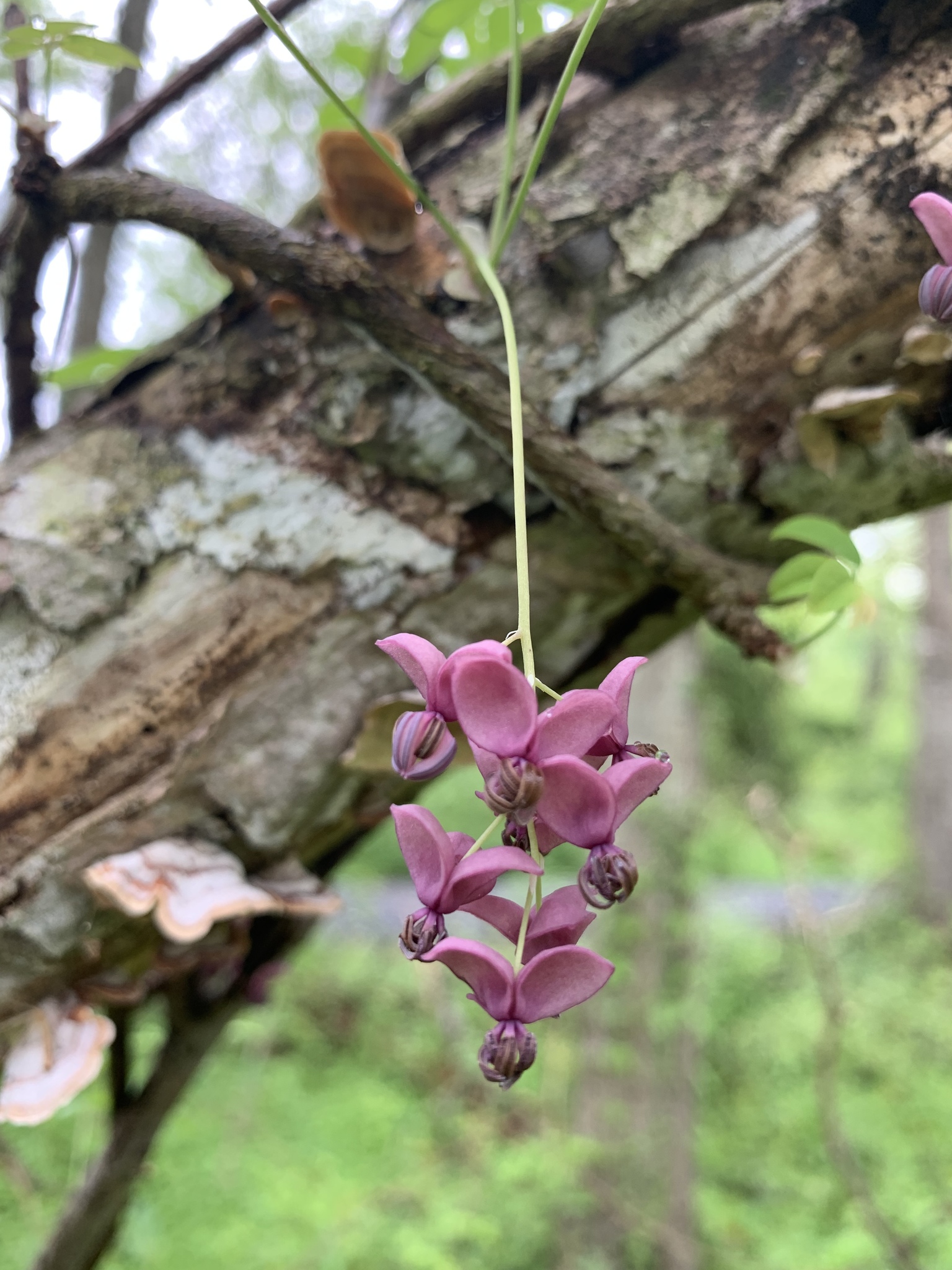Map Snapshot











48 Records
Status
Chocolate Vine was introduced to the United States from eastern Asia. This semi-evergreen vine can climb high into trees and smother native vegetation. The flowers are thought by some to smell like chocolate.
Where To Find
Becoming a problem in one area of the North Tract of the Potomac Research Refuge.
Seasonality Snapshot
Source: Wikipedia
| Akebia quinata | |
|---|---|

| |
| Scientific classification | |
| Kingdom: | Plantae |
| Clade: | Tracheophytes |
| Clade: | Angiosperms |
| Clade: | Eudicots |
| Order: | Ranunculales |
| Family: | Lardizabalaceae |
| Genus: | Akebia |
| Species: | A. quinata
|
| Binomial name | |
| Akebia quinata | |
| Synonyms | |
|
Rajania quinata Houtt. | |
Akebia quinata –commonly known as chocolate vine, five-leaf chocolate vine,[1] or five-leaf akebia, is a shrub that is native to Japan, China and Korea, commonly used as an ornamental / edible plant in the United States and Europe.[2] In its native habitat, it is often found on hills, in hedges, on trees, along forest edges and streams, and on mountainous slopes.[3]
Description
[edit]Akebia quinata is a climbing evergreen shrub that grows to 10 m (30 ft) or more in height and has palmately compound leaves with five elliptic or obovate leaflets that are notched at the tip.[4] The woody stems are greyish-brown with lenticels.[3] The flowers are clustered in racemes and are chocolate-scented, with three or four sepals. The fruits are sausage-shaped pods which contain edible pulp.[5][6] The gelatinous placentation contains seeds surrounded with white pulp, that has a sweet flavor.[citation needed]
Uses
[edit]Culinary
[edit]The fruit contains a sweet soft pulp resembling a white dragon fruit, eaten primarily in Japan as a seasonal delicacy. The rind, with a slight bitter taste, is used as vegetable, stuffed with ground meat and deep-fried.
Often eaten fresh, the Akebia fruit is best after it fully opens naturally on the vine.[7] The fruiting season is from September to October.[8] The seeds are very bitter and can even lead to throat irritation if chewed. They are discarded by spitting out or simply swallowing them whole. The fruit can be processed into jams, jellies, drinks and even added to smoothies or ice-creams.[7]
Ornamental
[edit]Akebia quinata is often grown as an ornamental plant in the United States, Canada, Europe and Asia. It is primarily used to cover less attractive spots on the sides of businesses or a ground cover to prevent erosion of hills.[9] The flowers bloom generally in April - May[10] and produce a "chocolatey" aroma which is often compared to vanilla or sometimes nutmeg rather than chocolate.[9]
Various breeders of the plant have created new subspecies with their own unique colored flowers. One of these is the "Silver Bells" Akebia which has silvery white flowers with purple stamen.[11] (see photo in Gallery)
Medicinal
[edit]Akebia quinata consumption has been shown in-vitro to lower cholesterol levels present in the blood of rodents.[12]

Akebia also has the ability to regulate chemicals in the kidneys, liver and cardiovascular system making it a health food if regularly consumed.[12]
The stem contains approximately 30% potassium salts thus causing a diuretic action.[13][unreliable medical source?]
The fruit is used in traditional Chinese medicine to treat urinary tract infections, scanty lactation, and rheumatoid arthritis.
Other
[edit]Traditionally, the vines have been used for basket-weaving which may help reduce the spread of this plant in the Eastern United States.
The dried rinds have been used in Japanese fertility festivals and due to their vulva-like appearance it is thought to increase the fertility of women, although there is no scientific evidence to support these claims.
Cultivation
[edit]
Akebia prefers sandy soils with good drainage, and regular watering, though it is drought resistant.[14] In some areas the plant is an invasive species to be avoided.[15][16] This species is considered hardy in all of the United Kingdom and Europe (down to -15 to -20 °C).[4] In the US, it suitable for hardiness zones 4–9.[17]
Akebia quinata, and all Akebia species for that matter, will not produce fruit if not pollinated by a genetically different plant (e.g., male flowers from the mother plant or the male flowers from a clone of the mother plant will not be able to pollinate the female flowers). Two separate varieties or two Akebia grown from separate seeds are needed to produce the sausage-like fruits.[18]
Etymology
[edit]Akebia comes from the Japanese vernacular name, akebi (木通)),[8][10][19] akebi was originally written as 開け実 derived from akeru (開ける, "to open") and mi (実, "fruit"), due to how its fruit splits open when ripe.[20][21]

Quinata means 'divided into five' and is presumably a reference to its lobed leaves.[19]
Distribution
[edit]
Akebia range
[edit]Akebia quinata is native to China, Japan (all major islands except Hokkaido[10]) and the Korean peninsula,[22] but is cultivated globally. This map represents sightings of both wild and cultivated plants.
Akebia in North America
[edit]Akebia quinata is a minor invasive species in the majority of the East Coast and was introduced in 1845 as an ornamental plant. This is because the plant has no natural predators or diseases in North America and can grow as it pleases. Its shade tolerance and ability to endure full sun allow it to adapt to nearly all conditions it is grown in. In the East Coast, Akebia quinata has been reported in Florida, Georgia, Alabama, Louisiana, Tennessee, South Carolina, North Carolina, Missouri, Kentucky, Virginia, West Virginia, Ohio, Indiana, Illinois, Delaware, Maryland, Pennsylvania, New Jersey, Massachusetts, Vermont, Connecticut, Rhode Island, and as far north as Michigan and Wisconsin.
On the West Coast of the United States, Akebia quinata has not become a very invasive species. However, it has been reported in Washington State and Oregon.
Gallery
[edit]-
Female flower and 5 male flowers in Mount Ibuki
-
White variety of Akebia
-
Botanical Illustration
-
Female flower (left) and male flower (right)
-
Pinker variety of A. quinata fruits
-
Bluish Fruits of Akebia
-
Silver Bells Akebia flowers
See also
[edit]References
[edit]- ^ English Names for Korean Native Plants (PDF). Pocheon: Korea National Arboretum. 2015. p. 345. ISBN 978-89-97450-98-5. Archived from the original (PDF) on 25 May 2017. Retrieved 25 January 2016 – via Korea Forest Service.
- ^ "Akebia". One Green World. Retrieved 2023-01-09.
- ^ a b Thompson, John Peter (November 22, 2019). "Akebia quinata (five-leaf akebia)". CABI Invasive Species Compendium. Archived from the original on 2017-07-25. Retrieved April 21, 2021.
- ^ a b "Akebia quinata | chocolate vine/RHS Gardening". www.rhs.org.uk. Retrieved 2021-04-21.
- ^ Levy-Yamamori, Ran; Ran Levy; Gerard Taaffe (2004). Garden Plants of Japan. Timber Press. ISBN 0-88192-650-7. Retrieved 2009-04-05.
- ^ "Decaisne, Joseph. Archives du Muséum d'Histoire Naturelle 1: 195, pl. 13a. 1839". Biodiversitylibrary.org. 2013-05-30. Retrieved 2018-05-31.
- ^ a b "Here's Everything You Need To Know Purple Akebi Fruit". Cookist.com. Retrieved 2023-01-09.
- ^ a b 西田尚道, ed. (2009). 日本の樹木. 増補改訂 ベストフィールド図鑑 (in Japanese). Vol. 5. Gakushūken. p. 12. ISBN 978-4-05-403844-8.
- ^ a b Bailey, L. H. (2005). Manual of Gardening (Second ed.). Project Gutenberg Literary Archive Foundation.
- ^ a b c 鈴木庸夫; 高橋冬; 安延尚文 (2012). 『草木の種子と果実』 (in Japanese). Seibundo Shinkosha. p. 200. ISBN 978-4-416-71219-1.
- ^ "Silver Bells ™ Akebia Vine". One Green World. Retrieved 2023-01-10.
- ^ a b Lee, Seul Gi; Lee, Eunbi; Chae, Jongbeom; Kim, Jin Soo; Lee, Han-Saem; Lim, Yu-Mi; So, Jai-Hyun; Hahn, Dongyup; Nam, Ju-Ock (2022-11-05). "Bioconverted Fruit Extract of Akebia Quinata Exhibits Anti-Obesity Effects in High-Fat Diet-Induced Obese Rats". Nutrients. 14 (21): 4683. doi:10.3390/nu14214683. ISSN 2072-6643. PMC 9656223. PMID 36364945.
- ^ Reid, Daniel (2001). A Handbook of Chinese Healing Herbs. Tuttle Publishing. ISBN 962-593-988-1.
- ^ "Akebia quinata (Chocolate Vine)". Gardenia.net.
- ^ "PlantFiles: Akebia Species, Chocolate Vine, Five-Leaf Akebia, Raisin Vine". Dave's Garden. 2003-04-15.
- ^ McIntosh, Jamie (2011-11-23). "Chocolate-Scented Flowers Make Akebia Vine Unique". The Spruce.
- ^ "Five Leaf Akebia Info". www.gardeningknowhow.com. 13 May 2012. Archived from the original on 2013-03-28. Retrieved 2021-04-21.
- ^ Thompson, J. P. (2022). Akebia quinata (five-leaf akebia) (Report). doi:10.1079/cabicompendium.3933.
- ^ a b Gledhill, David (2008). The Names of Plants. Cambridge University Press. pp. 40, 324. ISBN 9780521866453.
- ^ 田中孝治 (1995). 効きめと使い方がひと目でわかる 薬草健康法. ベストライフ (in Japanese). Kodansha. pp. 121–122. ISBN 4-06-195372-9.
- ^ 平野隆久, ed. (1997). 樹木ガイドブック (in Japanese). Nagaokashoten. p. 241. ISBN 4-522-21557-6.
- ^ "Akebia quinata (Thunb. ex Houtt.) Decne". Plants of the World Online. Royal Botanic Gardens, Kew.
External links
[edit]- https://www.invasiveplantatlas.org/subject.html?sub=10090
- Akebia quinata (Houtt.) Dcne. (ITIS)
- Akebia quinata (Houtt.) Decne. Medicinal Plant Images Database (School of Chinese Medicine, Hong Kong Baptist University) (in Chinese) (in English)
- Akebia quinata in the CalPhotos photo database, University of California, Berkeley






















